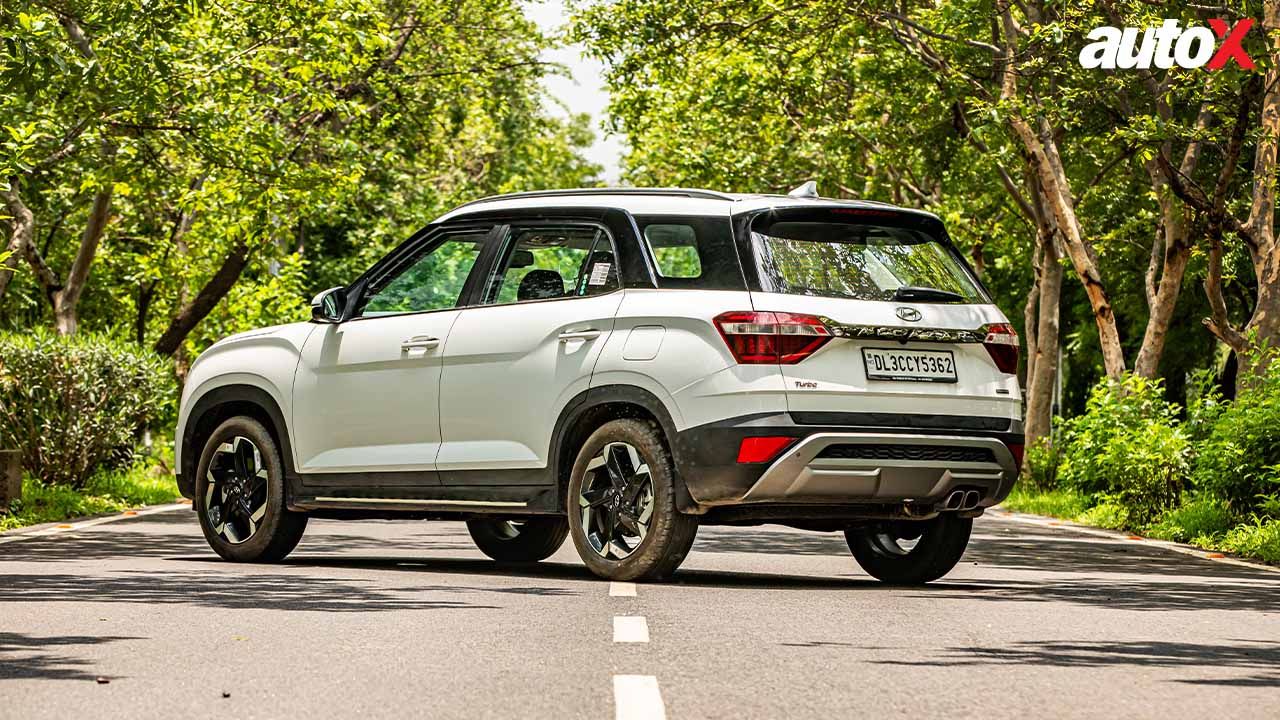These two offerings from the Hyundai Group are technically more or less the same but with different body styles. That said, the Kia Carens is categorised in the MUV segment, while the Hyundai Alcazar is from the compact SUV segment.
In India, there are only two Kia cars that belong to the MUV segment, while Hyundai India is yet to make a foray into the MUV segment. However, the Hyundai Alcazara and the Kia Carens are available in six- and seven-seater layouts.
In addition, both are feature-packed vehicles and have similar pricing. And, as far as the pricing is concerned, the Hyundai Alcazar is priced above the Kia Carens, be it a base or top variant.
So, without wasting time, let’s delve into the differences between these two three-row vehicles from the same group. Let’s read on.
Dimensions
In terms of dimensions, the Kia Carens is dimensionally bigger than the Hyundai Alcazar. The Kia Carens has a length of 4540mm, a width of 1800mm, a height of 1708mm, and a wheelbase of 2780mm.
On the other hand, the Hyundai Alcazar has a length of 4500mm, a width of 1790mm, a height of 1675mm, and a wheelbase of 2760mm.
Weighing their dimensions, the Kia Carens will be more spacious from the inside than the Hyundai Alcazar. That said, the former will offer more headroom, shoulder room, and legroom.

As for the ride height, the Hyundai Alcazar’s ground clearance is rated at 200mm, while the Kia Carens has a ground clearance of 195mm. Despite a difference of 5mm in ground clearance, these two vehicles shouldn’t be a concern, while driving on Indian roads. As recommended by the Society of Indian Automotive Manufacturers (SIAM), a passenger vehicle should atleast have 170mm of ground clearance in India.
In terms of boot capacity, the Kia Carens’ boot space is 216 litres, while the Hyundai Alcazar has 180 litres of boot space. These capacities are rated with all seats up.
In addition, you can check out the Kia Carens review to learn about its practicality.
Specifications
In terms of specifications, the Hyundai Alcazar and Kia Carens have the same underpinnings. Both are based on the Hyundai-Kia K2 platform. For reference, the said platform underpins several Kia- and Hyundai cars, such as the Sonet, Seltos, Carens, i20, Alcazar, Creta, Venue, and the fifth-generation Verna.
Plus, both are powered by the same engines. However, the Kia Carens has an optional 1.5-litre naturally-aspirated petrol engine. This engine has an output of 113 bhp at 6300 rpm and 144 Nm of peak torque at 4500 rpm.
This engine is not there in the Hyundai Alcazar. However, there are two common engines: a 1.5-litre turbo-petrol and a 1.5-litre turbo-diesel engine. As for the 1.5-litre turbo-petrol mill, it is tuned to churn out 158 bhp at 5500 rpm and 253 Nm of peak torque at 3500 rpm. And, at last, comes the 1.5-litre turbo-diesel unit. This engine can pump out 113 bhp at 4000 rpm and 250 Nm of peak torque at 2750 rpm.

Both vehicles are available in manual and automatic.
You can, however, check out the Kia Carens price list here.
As far as fuel efficiency is concerned, the 2023 Hyundai Alcazar’s mileage ranges between 14.5 km/l and 20/4 km/l. In parallel, the Kia Carens’ mileage ranges between 15.70 km/l and 21.30 k m/l. All are ARAI-claimed figures. However, it is worth mentioning that the mileage can vary with the engine and transmission combination, local traffic conditions and individuals’ driving styles.
Suspensions and Brakes
As mentioned earlier, these two locally-produced vehicles in India are designed by keeping the conditions of Indian roads in mind. Both cars will provide comfort but the Kia Carens will have an edge in providing extra comfort, as MUVs are known to be comfort-oriented. That said, both vehicles will have a slightly differently-tuned suspension setup.
However, the Kia Carens stands on a McPherson Strut with a coil spring at the front, alongside a coupled torsion beam axle with a coil spring at the rear. In addition, the same suspension setup can be found in the Hyundai Alcazar. To get an understanding of the Alcazar driveability, check out the Alcazar review here.
The braking duties are taken care of by all disc brakes on these two vehicles. The Korean carmaker has kept all disc brakes as standard.
Features
Both offerings have a long list of features. Plus, it is worth mentioning that the features mentioned here belong to the top-most variant of these two vehicles.
If you are a MUV-oriented buyer, check out the Carens price here.
As for the exclusive features of the Kia Carens, they include a brake assist, hill-descent control, a reverse camera with guidance, a remote sunroof (open/close) via the app, and Alexa compatibility. Further, it includes leather upholstery, a panoramic sunroof, rain-sensing wipers, and wireless- Android Auto and Apple CarPlay.
On the other hand, the Hyundai Alcazar’s exclusive features include a panoramic sunroof, a 360-degree camera, an electrically adjustable driver seat, a leatherette upholstery, an adjustable cluster brightness, and wired- Android Auto and Apple CarPlay. It also boasts a dual-view dashcam.
Now, the common features comprise 64-colour ambient lighting, auto-dimming IRVM, auto HVAC, auto headlamps, tyre pressure monitoring system, six airbags, emergency brake light flashing, child-seat anchorages, etc. They also have 12V ports, a multi-function steering wheel (with tilt and telescopic adjustabilities), parking sensors (front and rear), front ventilated seats (cooling only), and a sunglass holder. Other shared features are electric ORVMs, stock rear-side window blinds, voice command, a wireless charger, USB and auxiliary ports, a digital instrument cluster, a 10.25-inch touchscreen infotainment unit, and a Bose-sourced audio system.
Check out the Alcazar price list here.
For exterior lighting, both have LED DRLs, LED headlamps, LED taillights, and LED fog lamps.
On the safety front, both are equipped with six airbags, ABS with EBD, ESP, hill-hold control, traction control, child-seat anchorages, and speed-sensing door locks. Last, but not least, both have connected car technology. This feature allows the owner to access the vehicle status. It shows live location, last parked location, live speed, fuel level, maintenance information, emergency call, and other relevant information.
Prices and Variants
The Kia Carens is sold in six broad trims: Premium, Prestige, Prestige Plus, Luxury, Luxury (O) and Luxury Plus. It has a total of twenty-three variants.
The Kia Carens price starts at Rs 10.45 lakh for the base variant, the Premium Petrol MT, and goes up to Rs 19.45 lakh for the top variant, the X-Line Diesel AT 6 STR.
In parallel, the Alcazar is offered in eight wide trims: Prestige Executive, Prestige (O), Platinum, Platinum (O), Signature, Signature (O), Signature Dual Tone and Signature (O) Dual Tone. It also has a total of twenty-three variants.
The Hyundai Alcazar price starts at Rs 16.77 lakh for the base variant, the Premium Turbo-Petrol MT 7 STR, and goes up to Rs 21.23 lakh for the top variant, the Signature (O) AE 7 STR Diesel AT.
All are ex-showroom prices in Delhi, as of October 2023. Please note that these prices are subject to change without any prior notice to the customer. You can, however, visit the autoX website to access the latest location-based price list for your dream vehicle. For more, visit our website or connect with us on Facebook, Twitter, LinkedIn, Instagram, and YouTube. So, stay tuned! Check out the also specs comparisons of these suv’s in autox.
Read more: Reviving the Legacy: Look at the Royal Enfield Bullet 350 bikes







